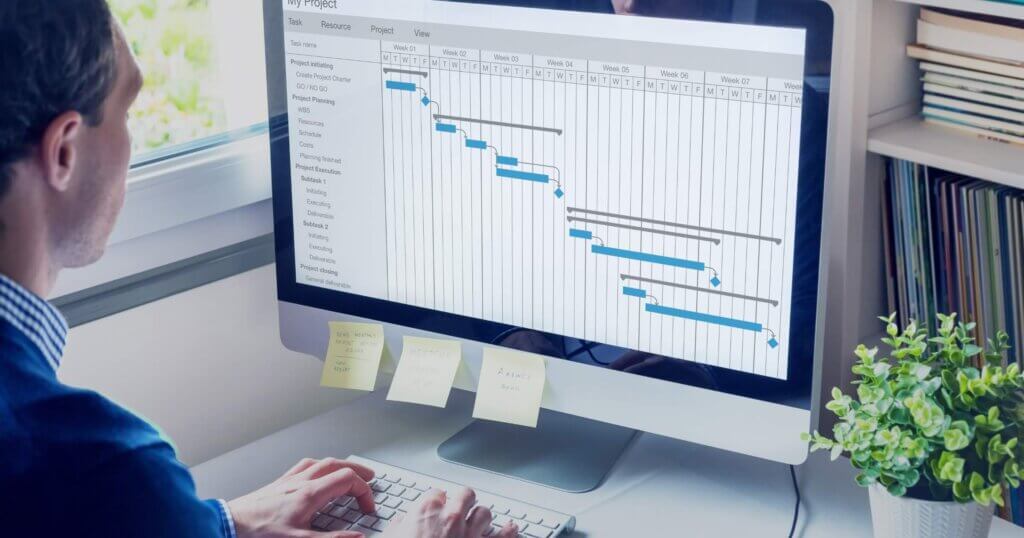It’s common for construction projects to be delayed and take longer than the expected timeline. These delays often come with added pressure which leads to stress for everyone involved. Without a strategy to tackle work stress, small issues can easily snowball into missed deadlines, team tension, and mental fatigue.
In this guide, we break down five practical tips to help you manage stress during long projects. From setting boundaries to mastering communication, these practical strategies will help you and your team handle projects with minimal disruption.
1. Break the project into smaller milestones
Stretching across months or quarters, projects can overwhelm you mentally. Lumped into one big timeline, it’s hard to feel progress. A simple strategy to manage large projects is to start by splitting that scope into bi-weekly or phase-based objectives. This creates small milestones which when completed, helps you and your team feel accomplished.
Milestones also create checkpoints where everyone can pause, refocus, and tackle the next chunk with clarity. When subs, supervisors, and owners see what’s coming in two-week blocks, it removes the guesswork and keeps expectations aligned.

Photo courtesy of Shutterstock.
Smaller goals also give foremen and PMs something tangible to measure progress against, rather than feeling like the job is stuck in neutral.
Practical steps:
- List all deliverables, assign dates for key stages
- Share milestone dates with the crew or clients
- Add mini-celebrations like team coffee breaks or onsite treats
2. Set boundaries for work and downtime
Long-running projects often blur into evenings or weekends. When we skip breaks or chain shifts together, stress builds slowly. Commit to start and stop times and make sure to set clear boundaries for when to do work and when to relax.
This could include:
- Setting a timer for lunch
- Keeping screen time limited to a certain amount of hours per day
- Responding to emails only during work hours
- Setting block times for personal time
Saying “yes” to one more hour here or one more check-in eventually wears people down and lets people blur the lines of work time and off time. On long projects, this blurred line eventually leads to mental and physical fatigue that affects your ability to make sound decisions. Setting boundaries at work is easily one of the best tips for managing stress at work.
3. Communicate early and often
Delaying check-ins with work crews and managing parties sets the stage for unpleasant surprises such as material shortages, scope creep, or revised specs. To avoid this, encourage the workers and teams to speak up early.
Was the delivery late? Can design specs be clearer?
Questions will naturally arise as the project moves forward so it’s especially important to have a channel where parties can communicate effectively. Any unspoken issues cause rework and pressure later whereas open communication builds trust and keeps the workflow smooth.
This doesn’t need to be formal. Even a ten minute huddle or end-of-day phone call keeps people aligned. The key is identifying what works for each person and party involved. The earlier you catch misalignment, the easier and cheaper it is to fix.
4. Stay active and manage your physical health
Tight deadlines and long days strain your mind and body. Incorporating exercise into your daily routine will help to offset some of the toll of managing long projects. Exercise can be anything from taking breaks to stretch, walking laps around the site, or standing while reviewing plans.
It can also be hitting the gym two to three times a week, going for a jog, or attending a yoga class. The benefits of exercise are well known and range from improving your sleep, mood, and muscular endurance.

Photo courtesy of Shutterstock.
Another common trap for people managing long projects is to skip meals and forget about hydration. Skipping meals overtime will decrease your energy and lead to brain fog. The same can be said for not drinking enough water. The best way to manage your physical and mental health is to come prepared in advance and have a plan. This can include:
- Meal prepping
- Bringing a water bottle
- Scheduling walks for lunch
- Having a workout routine
- Avoiding caffeine late in the day to help improve sleep
5. Use tools and routines to keep you organized
Nothing kills mental focus faster than scrambling to figure out what you need to do in the day. A tidy system of calendars, shared checklists, and project software reduces this last-minute chaos. When you have a routine at work your brain has a map of how to execute your tasks and what to prioritize.
Use apps like Asana, Trello, or even shared spreadsheets to manage your project timeline and tasks. These tools help you organize everything from design scope to daily tasks for crew members so nobody’s guessing. When your tools work for you, you waste less time putting out fires and more time making progress.
The benefits of managing stress at work
Taking action and implementing these tips for managing stress is the first step to making lasting change. When implemented, the benefits include:
More consistent performance
When large projects are broken into smaller chunks and downtime is protected, the work moves at a steadier pace. This makes it easier to track progress and shift resources early, instead of scrambling at the last minute. You avoid the cycle of last-minute catch-ups, long days, and avoidable delays. That stability keeps both crews and budgets on track.
Better decision-making
Simple daily routines like drinking water, taking breaks, and moving around will help you think more clearly. Physical stress feeds mental fog, which can lead to rushed or sloppy decisions on specs, scheduling, or safety. Keeping stress low makes it easier to weigh options, catch red flags, and make better calls when problems pop up. Even five minutes of reset time helps you stay sharp when it matters most.
Higher team morale
When leaders set boundaries and respect time off, the rest of the crew follows. People are more likely to speak up, support each other, and stay engaged when they aren’t constantly drained. It sends a message that the work matters, but so does the worker. Over time, teams that feel supported have fewer conflicts and better retention.
Greater job satisfaction
Long projects feel more manageable when progress is visible. When workers can see milestones being hit and aren’t buried in constant stress, the job feels more rewarding. It builds confidence and motivation, rather than fatigue. Even a small “win” each week makes a big difference in how someone views their role on the job.
Better safety
Stress and fatigue are two of the biggest reasons mistakes happen on the job. They dull attention, slow reaction times, and increase the risk of accidents, especially when working with tools, equipment, or height. Stress management keeps people alert and aware of their surroundings. That helps prevent injuries and reduces costly errors.
Want more tools to help you decrease stress at work? Check out our latest articles and resources including:
- Mental-health resources for executives
- Top mental-health and wellness apps
- 10 signs you might need a mental-health day
- Inside the construction industry’s battle with mental health
If you enjoyed these five tips on managing stress at work, we’ve got more for you! Our Under the Hard Hat newsletter delivers weekly health tips to help you and your team succeed on the job. Subscribe now and get them delivered straight to your inbox!


